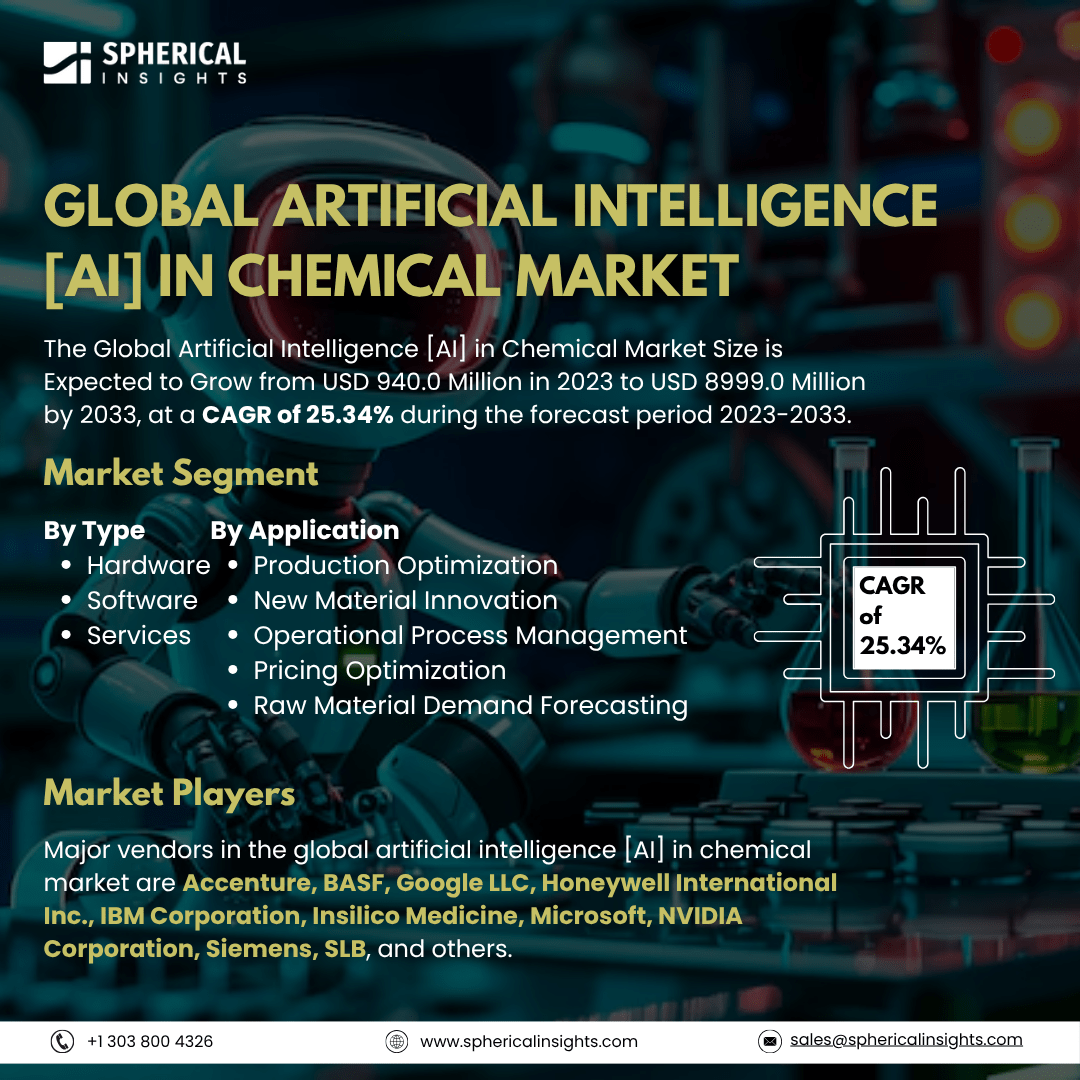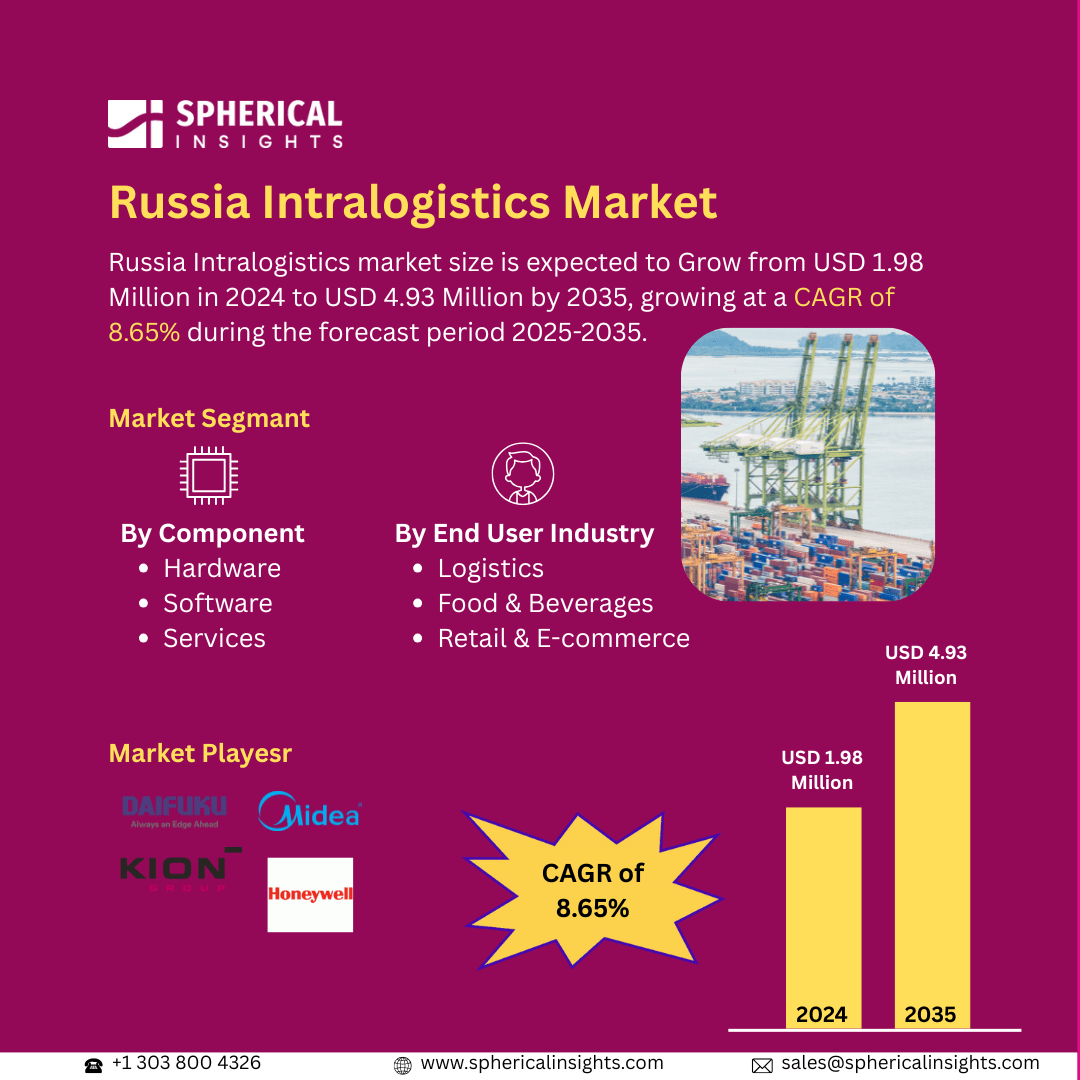Global Artificial Intelligence (AI) in Chemical Market Size To Exceed USD 8999.0 Million By 2033
According to a research report published by Spherical Insights & Consulting, The Global Artificial Intelligence (AI) in Chemical Market Size is Expected to Grow from USD 940.0 Million in 2023 to USD 8999.0 Million by 2033, at a CAGR of 25.34% during the forecast period 2023-2033.
Browse 210 market data Tables and 45 Figures spread through 190 Pages and in-depth TOC on the Global Artificial Intelligence (AI) in Chemical Market Size, Share, and COVID-19 Impact Analysis, By Type (Hardware, Software, and Services), By Application (Production Optimization, New Material Innovation, Operational Process Management, Pricing Optimization, Raw Material Demand Forecasting, and Others), By End-Use (Base Chemicals & Petrochemicals, Agricultural Chemicals, and Specialty Chemicals), and By Region (North America, Europe, Asia-Pacific, Latin America, Middle East, and Africa), Analysis and Forecast 2023 - 2033.
The artificial intelligence (AI) in the chemical market refers to the global industry involved in the production, distribution, and application of chemicals designed to eliminate or inhibit the growth of harmful microorganisms, including bacteria, viruses, fungi, and algae. These chemicals are widely used in healthcare, food processing, water treatment, paints & coatings, and industrial sectors to ensure hygiene, prevent infections, and maintain product integrity. The market encompasses various chemical types, such as alcohols, quaternary ammonium compounds, organosulfur compounds, and phenolics, driven by stringent health regulations, rising hygiene awareness, and technological advancements. Furthermore, key driving factors include rising demand for hygiene and infection control, increasing healthcare expenditures, and stringent regulatory policies on sanitation. Growth in food processing, water treatment, and industrial applications further boosts demand. Technological advancements in eco-friendly disinfectants and expanding awareness of antimicrobial resistance also contribute to market expansion, ensuring sustained growth over the forecast period. However, the stringent regulations, environmental concerns, high production costs, antimicrobial resistance, health hazards, and fluctuating raw material prices, limiting widespread adoption and market expansion across various industries, are key restraints for the growth of the market.
The software segment accounted for the largest share in 2023 and is anticipated to grow at a significant CAGR during the forecast period.
On the basis of the type, the global artificial intelligence (AI) in chemical market is divided into hardware, software, and services. Among these, the software segment accounted for the largest share in 2023 and is anticipated to grow at a significant CAGR during the forecast period. The segmental growth is attributed to the increasing adoption of digital solutions for monitoring hygiene compliance, infection control, and disinfection processes. Advancements in AI-driven sanitation management, rising demand for automation in healthcare and industrial sectors, and stringent regulatory requirements further drive its significant CAGR during the forecast period.
The production optimization segment accounted for the largest share in 2023 and is anticipated to grow at a remarkable CAGR during the forecast period.
On the basis of the application, the global artificial intelligence (AI) in chemical market is divided into production optimization, new material innovation, operational process management, pricing optimization, raw material demand forecasting, and others. Among these, the production optimization segment accounted for the largest share in 2023 and is anticipated to grow at a remarkable CAGR during the forecast period. The segmental growth is attributed to the rising need for efficient manufacturing processes, cost reduction, and sustainability in antimicrobial and disinfectant chemical production. Advancements in automation, real-time monitoring, and regulatory compliance drive demand, ensuring a remarkable CAGR as industries focus on maximizing efficiency and minimizing waste.
The base chemicals & petrochemicals segment accounted for the greatest share in 2023 and is anticipated to grow at a substantial CAGR over the forecast period.
On the basis of the end-use, the global artificial intelligence (AI) in chemical market is divided into base chemicals & petrochemicals, agricultural chemicals, and specialty chemicals. Among these, the base chemicals & petrochemicals segment accounted for the greatest share in 2023 and is anticipated to grow at a substantial CAGR over the forecast period. The segmental growth is attributed to its critical role in antimicrobial and disinfectant production. Rising demand for high-performance disinfectants, expanding industrial applications, and technological advancements in chemical synthesis drive growth. Increasing regulatory compliance and innovation in sustainable alternatives further support a substantial CAGR during the forecast period.
North America is projected to hold the largest share of the global artificial intelligence (AI) in chemical market over the forecast period.
North America is projected to hold the largest share of the global artificial intelligence (AI) in chemical market over the forecast period. The regional growth is attributed to stringent hygiene regulations, advanced healthcare infrastructure, and high consumer awareness. Strong demand from hospitals, food processing, and residential sectors, along with continuous R&D in innovative disinfectants, government support, and rising industrial applications, ensures sustained market leadership throughout the forecast period.
Asia Pacific is expected to grow at the fastest CAGR growth of the global artificial intelligence (AI) in chemical market during the forecast period. The regional growth is attributed to rapid industrialization, increasing healthcare investments, and rising awareness of hygiene and sanitation. Expanding urban populations, government initiatives for infection control, and growing demand from food processing, pharmaceuticals, and water treatment industries further fuel market expansion, making it the fastest-growing region.
Company Profiling
Major vendors in the global artificial intelligence (AI) in chemical market are Accenture, BASF, Google LLC, Honeywell International Inc., IBM Corporation, Insilico Medicine, Microsoft, NVIDIA Corporation, Siemens, SLB, and others.
Key Target Audience
- Market Players
- Investors
- End-users
- Government Authorities
- Consulting and Research Firm
- Venture capitalists
- Value-Added Resellers (VARs)
Recent Development
- In June 2024, Accelerated DFT and Generative Chemistry were two new features that Microsoft added to its Azure Quantum Elements platform to improve the productivity of chemistry and materials science research. The time required for intricate simulations is greatly decreased, and scientific research is advanced, through these updates that use AI and quantum computing to speed up the discovery and analysis of molecular compounds.
Market Segment
This study forecasts revenue at global, regional, and country levels from 2023 to 2033. Spherical Insights has segmented the global artificial intelligence (AI] in chemical market based on the below-mentioned segments:
Global Artificial Intelligence (AI) in Chemical Market, By Type
- Hardware
- Software
- Services
Global Artificial Intelligence (AI) in Chemical Market, By Application
- Production Optimization
- New Material Innovation
- Operational Process Management
- Pricing Optimization
- Raw Material Demand Forecasting
- Others
Global Artificial Intelligence (AI) in Chemical Market, By End-Use
- Base Chemicals & Petrochemicals
- Agricultural Chemicals
- Specialty Chemicals
Global Artificial Intelligence (AI) in Chemical Market, By Regional
- North America
- Europe
- Germany
- UK
- France
- Italy
- Spain
- Russia
- Rest of Europe
- Asia Pacific
- China
- Japan
- India
- South Korea
- Australia
- Rest of Asia Pacific
- South America
- Brazil
- Argentina
- Rest of South America
- Middle East & Africa
- UAE
- Saudi Arabia
- Qatar
- South Africa
- Rest of the Middle East & Africa



